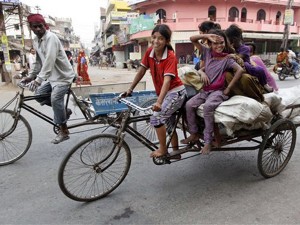India jolted by weak growth data

A rag-picker girl paddles her rickshaw carrying her friends after collecting polythene bags in Allahabad, India, on May 6, 2012. India's economy grew 6.5 percent for year to March 2012, lower than the government's estimate of 6.9 percent and far below the 8.4 percent of the previous year, data showed Thursday, May 31, 2012. AP PHOTO/RAJESH KUMAR SINGH
NEW DELHI—India’s economy grew a lower-than-expected 5.3 percent in the final quarter of the fiscal year, data showed Thursday, piling pressure on the embattled government.
The figures from the national statistics office also showed the economy expanded 6.5 percent for year to March 2012 – lower than the government’s estimate of 6.9 percent and far below the 8.4 percent of the previous year.
“The figures have reconfirmed the Confederation of India’s own estimates, which show that the economy is in the throes of a serious slowdown,” said Chandrajit Banerjee, director general of the leading industry body.
The final quarter of the last financial year saw a contraction in the key manufacturing sector, which saw output shrink 0.3 percent owing to flagging domestic and overseas demand, compared with 7.3 percent expansion a year earlier.
Farm, construction and mining production grew only modestly.
Article continues after this advertisementThe figures came as the rupee hit a record 56.50 low against the dollar and the government faced a nationwide strike to protest against the highest-ever petrol price hike that was put in place to curb oil firms’ losses.
Article continues after this advertisementShares on the Mumbai stock market fell as much as 1.38 percent.
“We are going through a rough patch worldwide. Growth figures have taken a hit because of that,” Rajesh Chakrabarti, professor of finance at the Indian School of Business, told India’s NDTV network.
But he added the data was “extremely disappointing.”
Analysts had forecast growth of 6.1 percent in the January-March quarter and the poor performance is likely to add to the gloom shrouding Asia’s third-largest economy.
The government has little room to increase spending to spur growth and interest rates cannot be cut significantly because of high inflation, which is sitting at around 7.0 percent.
Dariusz Kowalczyk, senior economist at Credit Agricole, had spoken of “extreme pessimism” about India’s prospects before the data was released.
“Fundamentals are indeed weak with slower growth, elevated inflation and the highest deficit-to-GDP ratios in Asia,” he said, forecasting annual growth will stay below seven percent until after the general elections in 2014.
Prime Minister Manmohan Singh, 79, admitted last week his scandal-tainted Congress-led ruling coalition “need to do better” to get the once red-hot economy moving again.
While more than six percent full-year growth would be the envy of much of the world, at least nine to 10 percent expansion is needed to reduce India’s widespread poverty, experts say.
India’s sluggishness will add to concerns about the global outlook as China also recently released a slew of bleak data, fueling fears the world’s second-biggest economy is cooling faster than expected.
Hopes the two emerging market giants, which weathered the 2008 financial crisis well, could underpin another global recovery have been steadily dashed by their stuttering performances.
Singh is credited with opening up India’s economy when he was the finance minister in 1991 but his premiership has been undermined by a series of policy U-turns and corruption scandals.
His once ambitious reform agenda has stalled amid coalition infighting, and the economic climate has been further strained by the announcement of new tax policies seen as hostile to foreign investment.
India’s economy is suffering from “policy incoherence, shifting global risk appetite and a comatose government,” said Rajeev Malik, senior economist at brokerage CLSA, said ahead of the figures.